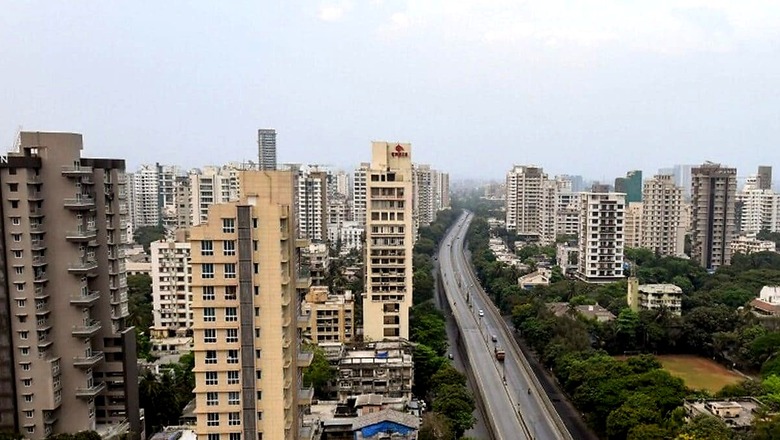
views
Mumbai city (area under BMC jurisdiction) saw property sales registration of 12,421 units in March 2023, contributing over Rs 1,143 Crores (Cr) to the state revenues. Of the total properties registered, 84% were residential while 16% were non-residential properties.
With a revenue collection of Rs 1,143 Cr in March 2023, Mumbai registered its highest revenue collection since April 2022.
According to a report by Knight Frank India, while rising mortgage rates stretched house purchase affordability, property sales in Mumbai remained buoyant due to robust consumer sentiment for home ownership.
The daily average property registration in March 2023 was 401 units, making it the third-best March month in the last ten years after March 2021.
The report added that the benefits of the stamp duty cut resulted in the highest average daily sale of 572 units in March 2021, while March 2022 saw an increase in property registration with an average daily sale of 540 units due to a rush in property registrations prior to the Metro cess being levied.
March in this financial year too will be the best month albeit driven primarily by homebuyer enthusiasm.
The report added that despite the fifth repo rate hike of 25 BPS in February 2023, which takes the cumulative increase to 250 BPS since May 2022, home buyers have continued to commit to purchase of residential property and the same is reflected in the numbers.

Shishir Baijal, chairman and managing director, Knight Frank India, said, “Notwithstanding recent interest rate increases, the strength of the Mumbai property market was on display in March. The market saw an increase in property registrations as it recorded its highest registrations for Fiscal Year 2023 in March 2023, driven by the resolute homebuyer desire for ownership. The state exchequer made significant gains supported by a rise in property registrations. This reflects the buoyancy of the Mumbai property market, which remains strong in the face of headwinds.”
500-1000 sq ft area continues to dominate property registrations.
In March 2023, apartments measuring 500 square feet (sq. ft.) to 1,000 sq. ft. continued to be purchasers’ preference, accounting for 48% of all apartments. Apartments with less than 500 sq. ft. saw a marginal decline in market share from 35% in January 2023 to 34% in March 2023. The share take – up for areas larger than 1,000 sq. ft. declined from 21% in February 2023 to 17% in March 2023.
82% sales in March 2023 in categories below Rs 2.5 Cr
In March 2023, homebuyers’ buying patterns on housing shifted, with Rs 2.5 Cr and below accounting for 82% of registered properties compared to 87% in February 2023, and Rs 2.5 Cr and above accounting for 17% of all registered houses compared to 14% in February 2023.
Western suburb and Central suburb account for 84% of the total market
Bulk of the sales registrations were for properties in Western suburbs constituting 62% of the market share in March 2023, while 25% of registrations were for properties in Central Mumbai. In March 2023, 6% of registrations were for Central Mumbai, while South Mumbai’s share of total property registrations stood at 7%.
The two markets of Central and Westerns Suburbs have in recent months seen large volumes of launches as a response to the robust demand. These locations provide great value as most of the new developments here provide for modern living amenities. Further, these locations are either already or are soon to be connected via the metro network which is further boosting the profiles for these properties.
The Central Suburb and Western Suburb have the highest percentage of property registrations under Rs 5 Cr. However, most transactions exceeding Rs 5 Cr. were registered in Central and South Mumbai.
Majority buyers prefer relocation within their micro markets
Consumers continued to favor staying in their local micro market in March 2023. The Central and Western Suburbs have demonstrated a significant propensity for buyers to upgrade to homes in their own micro market.
91% of buyers from Western and 82% of purchasers from Central suburbs choose to buy in their existing micro market as familiarity of the location is a key consideration for end users along with availability of products suited to their price and product requirements.
Approximately 5% of all Western suburbs house purchasers have moved to Central suburbs, while 9% of Central suburbs home buyers have moved to Western suburbs.
Homebuyers from the most desirable micro markets, including Central and South Mumbai, have a decreased inclination to buy real estate there. A home was bought in the same micro market by 57% of home buyers from Central Mumbai and 51% of home buyers from South Mumbai.
Residential properties in the Western and Central suburbs have drawn the most interest from purchasers outside of the city.
Home buyers of 31-45 years age category remain largest group of buyers
In March 2023, the age group of 31 and 45 made up the biggest percentage of home buyers, accounting for 44% of all residential property registrations. 10% of house purchasers are under 30 years old, while 33% of buyers are in the 46 to 60 age range.
In March 2023, the share of home buyers who were over 60 years old was 14%.
Read all the Latest Business News here



















Comments
0 comment